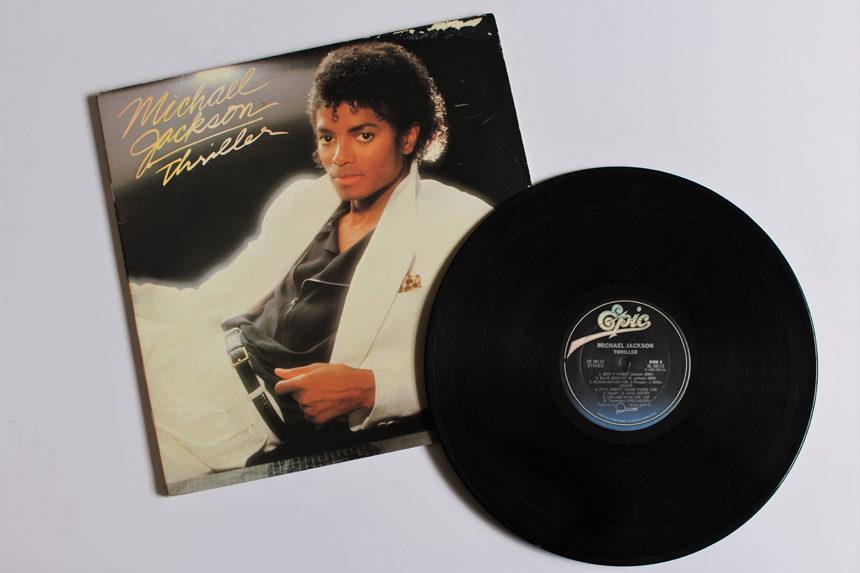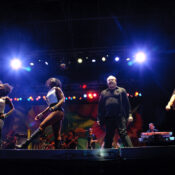What can you say about an album that made history by every conceivable metric? Popularity? Check. Cultural impact? Check. Sales? Check check checkity-check. Forty years ago this week, Michael Jackson’s Thriller hit stores, and the landscape of pop music in America shifted forever. From the seismic effect that Jackson and the album had on the music video form to the shattered sales records, Thriller emerged as a transformative force. Let’s break it down.
“Rock with You” (Uploaded to YouTube by Michael Jackson)
The Fifth Album
Jackson had been a star since the Jackson 5 broke out when he was ten. By 1979, he had left Motown Records after four solo efforts and started a new contract with Epic. The first Epic release, produced by Quincy Jones, was Off the Wall. The record sold 10 million copies and yielded multiple hits, notably “Rock with You,” “Don’t Stop ‘Til You Get Enough,” and the title track. But when the album failed to be recognized by the Grammys as Album of the Year, Jackson resolved to make a record that made sure that, according to an interview he gave to Ebony magazine, “every song was a killer.”
“Billie Jean” (Uploaded to YouTube by Michael Jackson)
Six Writers, Two Producers
Jackson re-enlisted Quincy Jones as producer, and also worked with Jones to co-produce four tracks. Jackson also wrote four of the new album’s nine songs (“Wanna Be Startin’ Somethin’,” “The Girl Is Mine,” “Beat It,” and “Billie Jean”). Jones and R&B star James Ingram co-wrote “P.Y.T. (Pretty Young Thing).” Toto’s Steve Porcaro co-wrote “Human Nature” with John Bettis, who wrote hits like “Top of the World” for The Carpenters. Rod Temperton, who had written “Off the Wall” and “Rock with You,” contributed three songs: “Baby Be Mine,” “The Lady in My Life,” and the title track, “Thriller.”
“Beat It” (Uploaded to YouTube by Michael Jackson)
One Guitar God and Three Toto Members
Understanding that public tastes had turned away from the more disco-inflected sound of Off the Wall, Jackson introduced a number of different elements to the record. For “Beat It,” Jackson and Jones brought in rock musicans to fill out the sound. Toto’s Steve Lukather (guitar, bass), Steve Porcaro (keyboards), and Jeff Porcaro (drums) filled vital roles. The distinctive guitar solo at the song’s midpoint came from Eddie Van Halen himself. Van Halen, who initially thought the call from Jones was a prank, did the solo for free just because he enjoyed doing it. The seasoned rock foundation gave Jackson a totally different sound and a massive, worldwide hit; the single alone sold 8 million copies in the U.S.
“Say Say Say” (Uploaded by Giraldi Media)
One Beatle, Twice
In 1981, Jackson and Paul McCartney recorded the song, “Say Say Say” for McCartney’s album Pipes of Peace. The next year, McCartney joined Jackson on “The Girl Is Mine.” Due to the vagaries of record label schedules, “Girl” ended up being Thriller’s first single and “Say Say Say” wouldn’t come out until 1983. “Girl” went to #2 in the States and “Say” hit #1. Unfortunately, those sessions led to a rift between the two friends. After McCartney advised Jackson on the wise investment of purchasing the publishing rights to songs, Jackson did just that in 1985: he bought the rights to 251 Beatles tunes from ATV, which had taken over the band’s Northern Songs publishing in 1969. The acquisition damaged their friendship and the two drifted apart. Jackson sold half of ATV to Sony in the ’90s; after Jackson’s death, Sony bought the rest from his estate. In 2017, McCartney filed to reclaim copyright on his Beatles tunes; Sony settled with the singer in a confidential agreement.
37 Weeks
After the album’s November 1982 release, it began to climb the charts. Buoyed by a steady stream of hit singles (“The Girl Is Mine” first, followed by “Billie Jean” in January and “Beat It” in February), Thriller reached #1 on February 26, 1983. Across 1983 and 1984, it would rack up 37 non-consecutive weeks in the top position, making it the best-selling album of each of those years.
1 Angry Record Executive
Almost immediately upon Thriller’s release, Jackson began changing the shape of music videos. While a number of other artists were making low-budget affairs, Jackson treated videos as actual filmmaking. Amazingly, MTV was going to pass on airing the video for Billie Jean until they were taken to task by CBS Records president Walter Yetnikoff; he not only promised that his label would boycott the still-young network, he swore that everyone would know that MTV’s primary reason for refusal was that they didn’t see a Black artist like Jackson fitting their vision for the network. Of course, the video’s popularity erupted. The one-two punch of Jackson and Prince in ’82 and ’83 opened the doors for Black artists at MTV. Heavy rotation of Jackson’s videos (and a major appearance on the Motown 25 anniversary special) drove Thriller sales to the point that, for a while, it was selling one million copies a week.
7 Top Tens
Each of Thriller’s seven singles made the Top Ten in the U.S. The final single, released almost a year after the album came out, was the title track, Thriller.
“Thriller” (Uploaded to YouTube by Michael Jackson)
13 minutes and 42 seconds with 3 Horror Icons
For the final video of the album, Jackson recruited John Landis to direct. Landis was known for films like Animal House and The Blues Brothers, but he’d also done the modern horror classic An American Werewolf in London. Rick Baker, the make-up effects genius who worked on Werewolf in addition to classics like Star Wars and Coming to America, created Jackson’s werecat transformation and the zombie dancers. A third horror legend, actor Vincent Price, participated via the “rap” he performed in the original recording. Jones had recruited Price for the album through his then-wife, The Mod Squad and Twin Peaks actress Peggy Lipton, as she and Price were friends. The video for Thriller was the longest take of the form at time, clocking 13 minutes and 42 seconds. Its release was an event, and it was soon sold as a VHS with a “making of” documentary. It’s generally regarded as the best music video ever, and was the first enshrined in the National Film Registry by the Library of Congress.
70 Million Copies
Though it’s occasionally been passed by other records, Thriller always makes it back to the top of the list of the best-selling albums of all-time. It’s certified to have sold 34 million units in the U.S. and a total of 70 million around the world. Among its many accolades were eight Grammys, eight American Music Awards, and induction into the National Recording Registry.
Become a Saturday Evening Post member and enjoy unlimited access. Subscribe now



